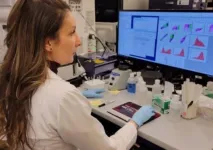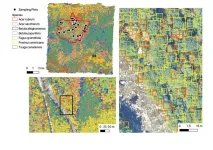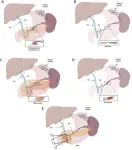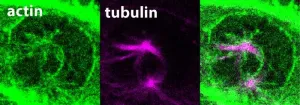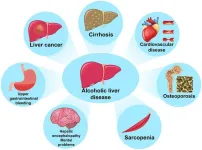(Press-News.org) An article published in the journal Cell describes a study that enabled a group of researchers to discover how SARS-CoV-2 evades the cytotoxic immune response by identifying a protein called ORF6 that is a key factor in this mechanism.
The cytotoxic immune response involves T-lymphocytes that kill pathogens when they recognize cells bearing a specific antigen while sparing neighboring uninfected cells.
The study was led by Wilfredo Garcia-Beltran and Julie Boucau, research scientists at the Ragon Institute of Massachusetts General Hospital (MGH), Massachusetts Institute of Technology (MIT) and Harvard University in the United States. The first authors of the article are Marcella Cardoso, a Brazilian postdoctoral research fellow at Harvard Medical School (HMS) and MGH, and Jordan Hartmann, also of HMS. Scientists affiliated with institutions in Brazil and Germany also took part.
“We discovered that SARS-CoV-2 is able to evade detection by the immune system by diminishing the vestiges that point to the presence of the virus in cells. In this process, the virus disturbs certain proteins on the surface of infected cells to inhibit interaction between them and T-lymphocytes,” Cardoso explained.
Defense cells known as natural killers (NKs) are fundamental to detect and combat viruses. They are part of the innate immune response, the first barrier against infection. NKG2D, a protein expressed on the surface of NKs, recognizes and kills infected cells (and cancer cells) by targeting stress-induced ligands released by the infection, such as MIC-A and MIC-B. This recognition is essential for contaminated cells to be removed from the organism.
Systematic analysis of the proteins in SARS-CoV-2 led to the finding that ORF6 – unique to and conserved among mammalian sarbecoviruses (the subgenus of Coronaviridae to which the virus that causes COVID-19 belongs) – participates actively in the removal of these important signalers of infected cells, facilitating viral proliferation in the host organism.
Confirming this evasion mechanism, when MIC-A and MIC-B receptors were protected with 7C6, an antibody used as a “shield”, NKs were far more successful in finding and destroying infected cells.
The co-authors of the article include four other Brazilians: Maria Cecília Ramiro, a PhD candidate at the State University of Campinas’s School of Medical Sciences (FCM-UNICAMP); and Fernanda Orsi, Lício Velloso and Erich de Paula, professors at FCM-UNICAMP.
According to De Paula, UNICAMP’s participation was linked to projects funded by FAPESP during the pandemic.
“Our group collaborated with the discussion of strategies and the sharing of a clinical cohort used to validate the data,” he said.
De Paula was principal investigator for the project “Evaluation of the mechanisms of hemostatic activation in COVID-19 and their modulation by bradykinin inhibitors”.
Velloso was principal investigator for the project “Clinical trial of bradykinin inhibition in hospitalized adults with severe COVID-19”, from which some of the clinical data and samples were obtained.
“Studies of the immune response in severe COVID-19 patients showed that this elimination of proteins also occurred in these cases. Data collected from patients during hospitalization were key to this cross-border research project, demonstrating the importance of the role of collaborative research with hospitals to contain pandemics in real time,” Cardoso said.
Samples collected at UNICAMP’s general and teaching hospital (Hospital de Clínicas) displayed greater diversity of clinical outcomes in response to the action of different strains of the virus. “In parallel, we conducted in vitro experiments in which lung tissue cells were infected with the live virus,” Cardoso said.
Monoclonal antibodies and new research fronts
In light of recent preclinical oncological trials showing that monoclonal antibody 7C6 can prevent elimination of MIC-A and -B (which stimulate NKs and T-cells), the researchers decided to see if it would also be effective to curtail evasion of the immune system by the virus.
“We expected this approach to not only stimulate elimination of infected cells but also increase co-stimulation of CD8+ T cells [lymphocytes of the adaptive immune system, often called cytotoxic T lymphocytes, or CTLs], thus activating both the innate and adaptive immune systems,” Cardoso explained. A series of experiments and in vitro assays were conducted to test the hypotheses.
“Knowing how SARS-CoV-2 and other coronaviruses affect these proteins and how this influences the immune response helps us understand better how they interact with the body. It also helps identify possible targets for novel treatments to strengthen the immune system and combat viral infections,” Cardoso said.
The results open up research fronts in the field of host-directed antiviral therapies since the discovery of the role played by the antibody 7C6 in boosting the elimination of cells infected by SARS-CoV-2 also points to possible innovative therapeutic strategies.
“Based on these results, it will be possible to conduct in vivo trials using transgenic animal models with the aim of evaluating the clinical applicability of the strategy. Further stages of the research are still needed, but the results are highly promising,” Cardoso said.
About São Paulo Research Foundation (FAPESP)
The São Paulo Research Foundation (FAPESP) is a public institution with the mission of supporting scientific research in all fields of knowledge by awarding scholarships, fellowships and grants to investigators linked with higher education and research institutions in the State of São Paulo, Brazil. FAPESP is aware that the very best research can only be done by working with the best researchers internationally. Therefore, it has established partnerships with funding agencies, higher education, private companies, and research organizations in other countries known for the quality of their research and has been encouraging scientists funded by its grants to further develop their international collaboration. You can learn more about FAPESP at www.fapesp.br/en and visit FAPESP news agency at www.agencia.fapesp.br/en to keep updated with the latest scientific breakthroughs FAPESP helps achieve through its many programs, awards and research centers. You may also subscribe to FAPESP news agency at http://agencia.fapesp.br/subscribe.
END
Study identifies protein that helps COVID-19 virus evade immune system
Discovery of a new viral evasion mechanism, and of a monoclonal antibody that subverts it, is an advance in immunotherapy offering the prospect of effective host-directed treatment to combat infections.
2024-07-16
ELSE PRESS RELEASES FROM THIS DATE:
Scientists use machine learning to predict diversity of tree species in forests
2024-07-16
A collaborative team of researchers led by Ben Weinstein of the University of Florida, Oregon, US, used machine learning to generate highly detailed maps of over 100 million individual trees from 24 sites across the U.S., publishing their findings July 16th in the open-access journal PLOS Biology. These maps provide information about individual tree species and conditions, which can greatly aid conservation efforts and other ecological projects.
Ecologists have long collected data on tree species to better understand a forest’s unique ecosystem. Historically, this has been done by surveying small plots of land and extrapolating those findings, though this cannot account for ...
Machine learning helps define new subtypes of Parkinson’s disease
2024-07-16
Researchers at Weill Cornell Medicine have used machine learning to define three subtypes of Parkinson’s disease based on the pace at which the disease progresses. In addition to having the potential to become an important diagnostic and prognostic tool, these subtypes are marked by distinct driver genes. If validated, these markers could also suggest ways the subtypes can be targeted with new and existing drugs.
The research was published on July 10 in npj Digital Medicine.
“Parkinson’s disease is highly heterogeneous, which means that ...
Weight loss influences risky decisions in obesity
2024-07-16
People who are severely overweight (obese) not only exhibit altered risk behavior, but also changes in their metabolism and psyche. It was previously assumed that severely obese people are more impulsive and show an increased willingness to take a risk. Scientists from the DZD partner German Institute of Human Nutrition Potsdam-Rehbrücke (DIfE) have now investigated whether massive weight loss leads to an improvement in metabolic and psychological states and whether decision-making is improved. The results were published in the journal 'Clinical Nutrition'.
Being overweight can cause metabolism to slip
Our behavior depends on many factors. ...
EurekAlert! Travel Awards recognize early-career science journalists in Eastern Europe for the first time
2024-07-16
The winners of the 2024 EurekAlert! Travel Awards are Pavla Hubálková, a Czech science journalist at WIRED.CZ, and Iris Duțescu, a Romanian freelance science journalist.
An independent panel of three judges with regional science journalism expertise selected the winners. Both awardees will receive travel support from EurekAlert! to attend the 2025 Annual Meeting of the American Association for the Advancement of Science (AAAS) in Boston, Mass., where they will have opportunities to cover the latest scientific research and make connections with scientists ...
Etiologies of splenic venous hypertension
2024-07-16
Splenic venous hypertension (SVH), also known as left-sided portal hypertension, is a rare condition characterized by upper gastrointestinal (GI) bleeding in the absence of liver disease. This condition arises due to increased pressure in the splenic vein (SV), causing blood to drain through the short gastric veins to the stomach, leading to the dilation of submucosal structures and the formation of gastric varices. Unlike traditional portal venous hypertension (PVH), SVH does not involve elevated pressures in the main portal vein and is primarily an extrahepatic condition. Diagnosing SVH requires ...
Breakthrough in quantum microscopy: Stuttgart researchers are making electrons visible in slow motion
2024-07-16
"With the method we developed, we can make things visible that no one has seen before," says Prof. Sebastian Loth, Managing Director of the Institute for Functional Matter and Quantum Technologies (FMQ) at the University of Stuttgart. "This makes it possible to settle questions about the movement of electrons in solids that have been unanswered since the 1980s." However, the findings of Loth's group are also of very practical significance for the development of new materials.
Tiny changes with macroscopic consequences
In ...
E-sales of a wild bat sold as décor threaten species
2024-07-16
A fiery orange bat, its wings folded and tiny teeth forever bared on its fuzzy face, is mounted inside a 6-inch, black coffin. Its retail price: $59. Or, for $140, you can get one framed with its black and orange wings spread, deliverable in two days.
Despite declining numbers in the wild, hundreds of specimens like this of Kerivoula picta—or painted woolly bat—are being sold on Etsy, eBay and Amazon as jewelry, Halloween decorations, and jarred curios.
A study published July 9 in the European Journal of Wildlife Research found “abundant evidence that ...
Social media polls deliberately skew political realities of 2016, 2020 US presidential elections, finds research team led by UMass Amherst
2024-07-16
AMHERST, Mass. – Informal political polls conducted on X/Twitter during both the 2016 and 2020 U.S. presidential elections were significantly skewed by questionable votes, many of which may have been purchased from troll farms. This conclusion, reached by a team of scientists led by Przemyslaw (Przemek) Grabowicz, research assistant professor at the University of Massachusetts Amherst, shows that X/Twitter’s poll system deliberately reports biased public vote counts. On average, the results of such questionable polls favored Donald Trump over Joe Biden, 58% to 42% in a head-to-head comparison, during 2020.
The team additionally found that ...
Unique characteristics of previously unexplored protein discovered
2024-07-16
An international research collaboration, led by Prof. Dr. Robert Grosse (Centre for Integrative Biological Signalling Studies and Institute of Clinical and Experimental Pharmacology and Toxicology, University of Freiburg), Dr. Libor Macurek (Institute of Molecular Genetics, Czech Academy of Sciences, Prague) and Dr. Zdenek Lansky (Institute of Biotechnology, Czech Academy of Sciences, Prague) has uncovered a new mechanism of the crosstalk between microtubules and actin cytoskeleton during cell division and ...
Alcoholic liver disease in China: A disease influenced by complex social factors that should not be neglected
2024-07-16
Alcoholic liver disease (ALD) is a major cause of liver-related morbidity and mortality globally. Chronic alcohol consumption, a primary driver of ALD, leads to a spectrum of liver conditions ranging from fatty liver to cirrhosis and hepatocellular carcinoma. In China, the incidence of ALD has been rising at an alarming rate, reflecting the country's rapid economic growth and changing social norms around alcohol consumption. This paper explores the complex social factors influencing ALD in China, the complications ...
LAST 30 PRESS RELEASES:
Numbers in our sights affect how we perceive space
SIMJ announces global collaborative book project in commemoration of its 75th anniversary
Air pollution exposure and birth weight
Obstructive sleep apnea risk and mental health conditions among older adults
How talking slows eye movements behind the wheel
The Ceramic Society of Japan’s Oxoate Ceramics Research Association launches new international book project
Heart-brain connection: international study reveals the role of the vagus nerve in keeping the heart young
Researchers identify Rb1 as a predictive biomarker for a new therapeutic strategy in some breast cancers
Survey reveals ethical gaps slowing AI adoption in pediatric surgery
Stimulant ADHD medications work differently than thought
AI overestimates how smart people are, according to HSE economists
HSE researchers create genome-wide map of quadruplexes
Scientists boost cell "powerhouses" to burn more calories
Automatic label checking: The missing step in making reliable medical AI
Low daily alcohol intake linked to 50% heightened mouth cancer risk in India
American Meteorological Society announces Rick Spinrad as 2026 President-Elect
Biomass-based carbon capture spotlighted in newly released global climate webinar recording
Illuminating invisible nano pollutants: advanced bioimaging tracks the full journey of emerging nanoscale contaminants in living systems
How does age affect recovery from spinal cord injury?
Novel AI tool offers prognosis for patients with head and neck cancer
Fathers’ microplastic exposure tied to their children’s metabolic problems
Research validates laboratory model for studying high-grade serous ovarian cancer
SIR 2026 delivers transformative breakthroughs in minimally invasive medicine to improve patient care
Stem Cell Reports most downloaded papers of 2025 highlight the breadth and impact of stem cell research
Oxford-led study estimates NHS spends around 3% of its primary and secondary care budget on the health impacts of heat and cold in England
A researcher’s long quest leads to a smart composite breakthrough
Urban wild bees act as “microbial sensors” of city health.
New study finds where you live affects recovery after a hip fracture
Forecasting the impact of fully automated vehicle adoption on US road traffic injuries
Alcohol-related hospitalizations from 2016 to 2022
[Press-News.org] Study identifies protein that helps COVID-19 virus evade immune systemDiscovery of a new viral evasion mechanism, and of a monoclonal antibody that subverts it, is an advance in immunotherapy offering the prospect of effective host-directed treatment to combat infections.
